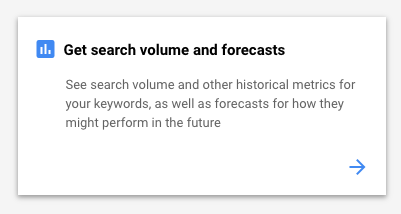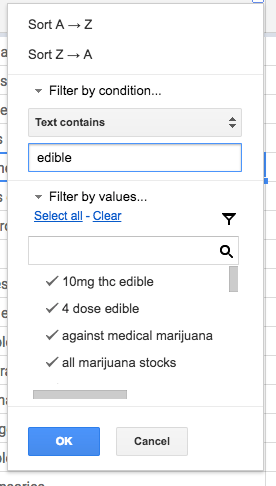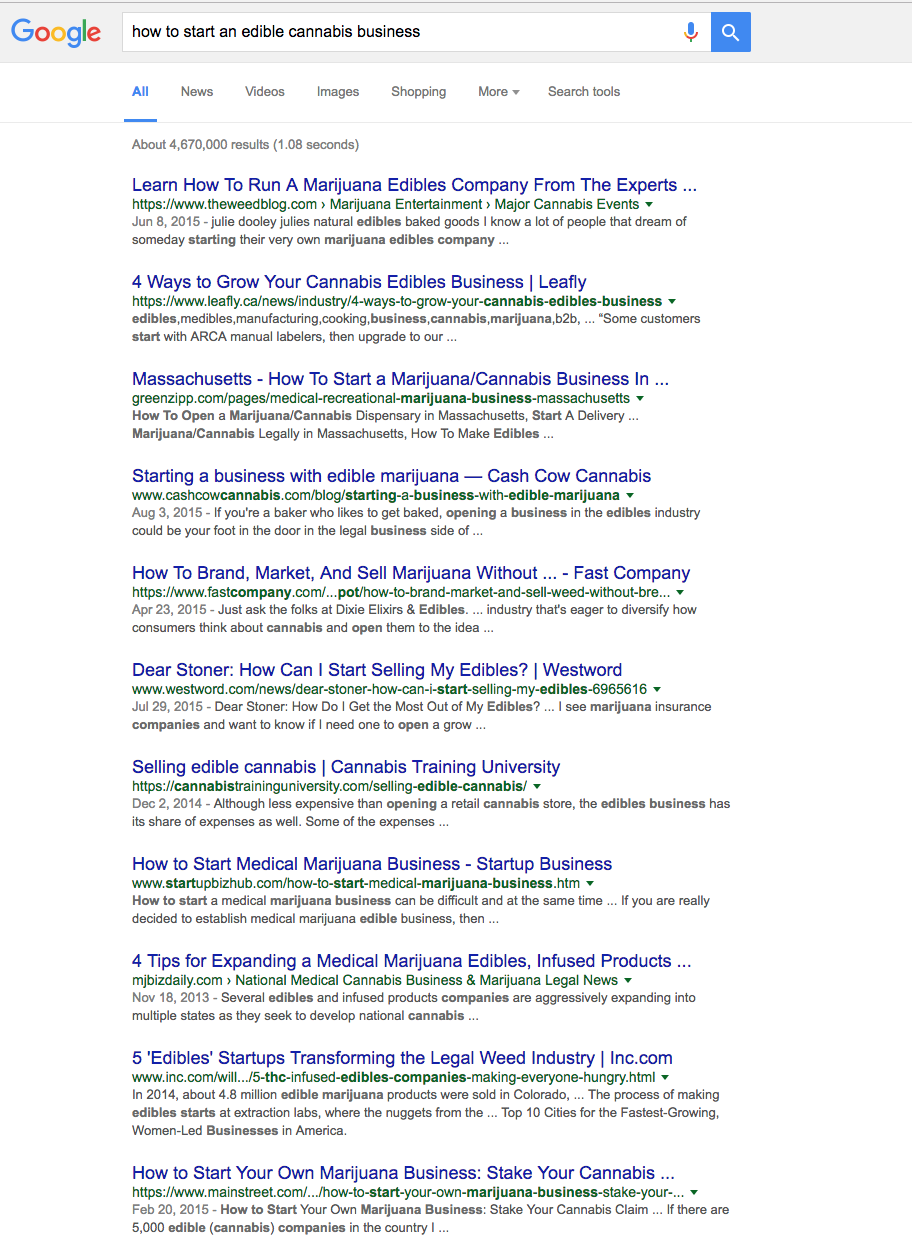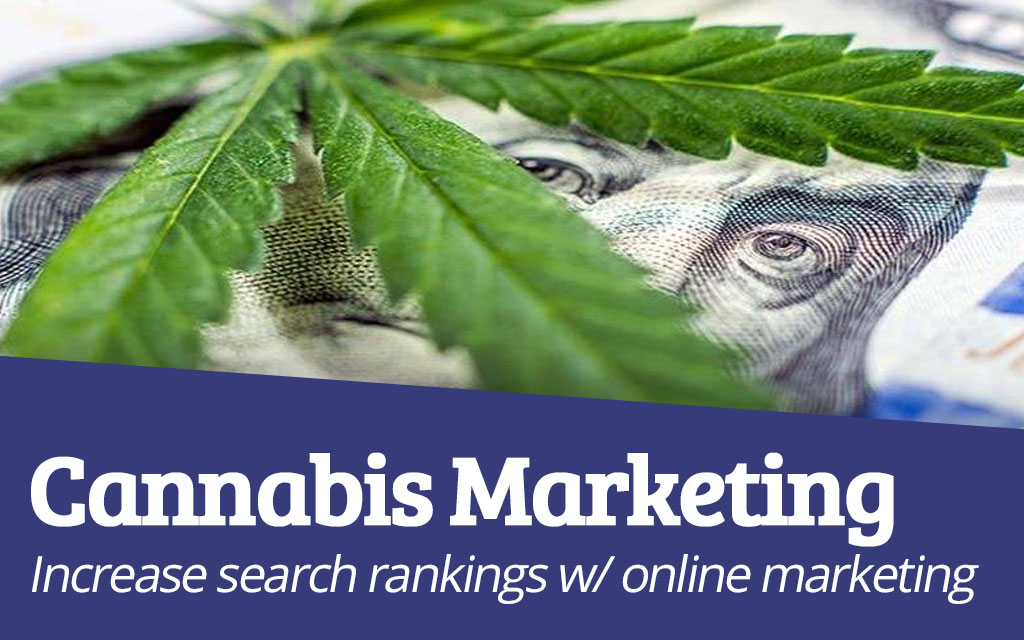Content marketing in the cannabis cannabis industry is easy if you’re able to step away from the ‘tactics’ and look at the bigger picture. Start your campaign from your end goal (such as increasing your rankings in search engines), and work your way backwards.
In this article we take a look at marketing cannabis companies and the methods cannabis businesses can implement to market online.
‘Cannabis Marketing’ is dead.
Long live ‘Marketing’ !
The truth is, cannabis marketing (content marketing for the cannabis industry) is no different than any other content marketing.

You start by creating amazing, valuable content, then promote it in places to show up when your potential customer is searching.
Simple, right? It takes minutes to understand, and a lifetime to master.
In it’s simplest form, you want people to see your name (or brand; or company; or website, etc.) when searching for information.
When you think of search engines, we typically default to Google, but there are many, many others. (More on that later, let’s get back to showing up in front of people who are looking for specific information.)
In order for you to get in front of them, you’re going to ‘reverse engineer’ that statement to understand where you want to be showing up, and then building content that’s so amazing, the search engine has no choice but to show the user your content.
Here’s what I mean… There are two pieces to the above statement (“you want people to find you when they’re searching”):
- They search for something
- Your name comes up
If you get answers to the questions surrounding those two pieces, you’ll begin to see where your opportunity lies to craft great cannabis content, and land directly in front of them (Remember: this works across any marketing channel, in any industry, for any business… we’re just focused on cannabis marketing today).
So here are some questions we can ask about each above statement:
- They search for something becomes
- “What are they searching for?”
- “Where are they searching?”
- Your name comes up becomes
- “How do I get my name there?”
We’re going to try to answer those questions today, and if you can do the same for your cannabis business, you’re well on your way to being an unstoppable force in the marketing world.
Assuming you’re looking at Google (but you could be looking at YouTube, Reddit, Quora, Twitter, any number of Forums, or any other social network – think about the concept of a ‘community’, and wherever that exists lies an opportunity for you), the answer to finding out, “what are they searching [on Google]?” is to go out and put together a set of keywords which people are searching, and find keywords that you’re able to turn into a blog post and create some awesome content for.
What are keywords and how do they affect my cannabis marketing campaign?
For those new to online marketing, the term itself may be fuzzy; ‘keyword’ refers to whatever the user is searching.
They’re the literal search terms that your potential buyers, customers, clients, and stoners are typing in when they search Google.
To find out where and what these terms are, people use all kinds of available data. I couldn’t begin to list all the methods so I’ve focused on a few that work well for us here at the agency that are easy enough for a cannabis business owner or marketing manager who’s unfamiliar with the process to pick up and start running with on your own marketing campaign.

Often when searching for keywords, there’s an app involved to do the heavy lifting. In this blog post I’ve outlined the process with LongTail Pro, a paid keyword research told for marketing, but there are many others and none are ‘better’ than the rest. Find what works for you. If you want to follow along with Long Tail Pro, here’s a link to get 30% OFF.
Since not everyone’s into paying money for a tool like this, I’ve also included how to do the process with free tools, and another super potent method of doing something very similar without using any tools at all.
If none of the tools, or apps mentioned in this post work for you, I have compiled an enormous list of free online marketing tools in another post, as well.
If you’ve ever wondered how to do content marketing at scale, bookmark this post, dig in, read it again, execute on it, then come back and brush up. There’s a lot to take in but I wanted this to be a one-stop shop when it comes to cannabis marketing.
This same process can be applied to any industry, and our boutique marketing agency is a testament to that, since it’s what we do all day, every day, day-in, day-out to grow organic traffic every month.
The power of the long tail: What are long tail keywords and why are they valuable to your cannabis content marketing campaign
You’ll have a harder time ranking for a term like ‘wholesale cannabis distributors’ if you’re not already an authority online as a wholesale cannabis distributor, and at the end of the day Google wants the searcher to find the most relevant results.

Your way around this is to first target that keyword with modifiers attached to it.
Here are some examples of modifiers which each change the keyword slightly:
- list of wholesale cannabis distributors
- reliable wholesale cannabis distributors
- best wholesale cannabis distributors
- wholesale cannabis distributor reviews
These are all examples of content that any cannabis blog would rank based on search intent, and are considered ‘long tail’ keywords which means they are not searched as often as the shorter, punchier keywords, and we’re going to use this to our advantage. You’re small, so tackle the small searches. When you’re medium, target the medium searches. When you’re big, target the big keywords.
If you don’t know where you are at the moment, don’t worry… start small and work your way up. In no time, you’ll have a strong understanding of where your cannabis brand sits within the industry.
A common mistake that business owners make is to be small and try to target large search terms; by trying to stretch your authority too much, you will inevitably have to resort to black hat (read: illegal) tactics to rank on the first page, and once you get there, the slightest change in Google will blow your rankings away.
It’s much smarter – and easier – to start with building an ant hill, then building yourself into a mountain based off a solid foundation.
In your new role as a cannabis marketing manager, a large chunk of your time developing new content will be spent uncovering keywords, assessing what it will take to rank for them, and looking at competition. At least as much time will be spent looking at keywords as will be spent on writing the content.
Here is our basic process here in the office:
- Find keywords people are searching to get an idea of what questions your potential customers are asking, and what information people your industry are looking for
- Pick a keyword that’s has a bit of search volume, where the quality of search results could be better. At the same time we’ll round up a handful of smaller, accompanying keywords to support the main keyword and to help round out the article, or content you’re creating
- Write an amazing article surrounding that keyword topic; content that covers everything anyone could ever want to know about the keyword topic you chose
- Reach out to industry leaders and influencers to drive traffic and build natural links to your content. (We’re not going to cover the outreach part of this process in this article but have covered it in depth in the past)
That’s it! The process is simple, and it works.
The trade-off for simple + effective is that it takes consistent work. It’s not a difficult process, but it’s takes time to learn, time to work on, and effort to implement. With that said, if you’re not afraid of a bit of hard work, this blog post is all you need succeed with a cannabis content marketing plan.
How to uncover relevant keywords for your cannabis marketing campaign using Google’s organic results
One of the best ways to get a list of potent keywords for your campaign is to go directly to Google. From there you have a bunch of available options to drum up relevant keywords for your business. Below, I’ve outlined a couple of methods we use in-house.
We typically start by taking a look at search results on Google’s first page or two, and understanding the type of content people are looking for (and that Google’s rewarding) given a specific term. We’re not using an app at this point, just using intuition to get an idea of what’s being served given a certain keyword/search term.
Sometimes you’ll find a review, or a blog post, and others you’ll find a product, or product comparison page. This gives you a good idea in understanding ‘search intent’, and what type of content Google’s looking to serve to people who search that term.
After we’ve got a decent understanding of what the searcher is looking for given a term, our next step is to understand the other pieces of the puzzle which is where tools and apps specifically built to uncover keywords come into play.
Let’s take a look at what that initial keyword research looks like, to get an understanding of both (a) what this person is looking for, and (b) what type of content Google’s interested in showing. We do that by looking at the various signals Google is presenting as alternative search options to the person making the search, for the search term they had initially searched.
Start by using Google’s suggestion boxes to uncover similar keywords for your campaign
Using autocomplete to find relevant keywords is a great method because it digs into what people are actually searching which typically offers great insight, and a bunch of great keywords to target since they’re the keywords Google itself is suggesting to their visitors.
Tapping into Google’s suggestions is dead simple. Go to Google’s homepage, and start typing in your search term, but don’t click/submit the search.
 Here, I typed, ‘how to cannabis company’ then wait for Google to spit back “suggested searches” for me to search.
Here, I typed, ‘how to cannabis company’ then wait for Google to spit back “suggested searches” for me to search.
As a marketer or content creator, you can take advantage of this predictive algorithm.
Here, Google’s predicting what you might be looking for by polling past searches of other people. If the past is any indication of the future, you know what people will be searching.
By changing one letter at a time, you can see more and more suggested searches. For now we’re going to keep it simple, you can see the 6 suggested searches are:
- how to start a cannabis company
- how to make your own cannabis company
- how to start a cannabis seed company
- how to start a cannabis extract company
- how to open a cannabis seed company, and…
- how to start a cannabis edible company
Without looking at how much traffic each of these searches is getting each month – an strong indicator worth tracking – you can see that virtually any of them could be its own blog post, and since they’re the top 6 suggestions Google’s showing their visitors, and it’s likely those search terms/keywords are keywords people are asking and wanting the answer to.
From here you can take the keywords to Google’s Keyword Planner, and figure out which makes sense to target further. I go into more detail later on using the Keyword Planner to uncover opportunities for you, but for now let’s stay on topic.
If looking to attract traffic from a cannabis edibles company, perhaps you put ‘how to sell edibles to dispensary’, and take a look at what comes up.

You could do an article for each of California, Colorado, and Washington, or at the very least you’ve learned to add the word ‘cannabis’ before edibles, and turn dispensary to dispensaries in order to fall in line with the exact term that Google’s visitors – in this case, likely a cannabis edible maker – are searching for.
To expand on that, if you’d rather write a single, giant post, you could write a larger post title How To Sell Cannabis Edibles To Dispensaries Broken Down By State which targets all of the above keywords. Each state gets a headline/title and you write one giant post that covers everything an edible company could dream of needing to know. In this case, your on-page optimization should be razor sharp.
Another way to dig up keywords is Google’s Related Searches box right from the search results
 If the Suggested Search autocomplete trick didn’t find the keywords you’re looking for, scroll down to the bottom of the search results page and look for the Related Searches box.
If the Suggested Search autocomplete trick didn’t find the keywords you’re looking for, scroll down to the bottom of the search results page and look for the Related Searches box.
If you scroll to the bottom of the results, you’ll see a box which says something along the lines of, ‘Searches related to [insert your keyword search term]‘ – in it, you’ll find related search terms that surround, support, or are otherwise connected the search term you searched for.
Here, I searched hemp shoes, and you can see it highlights some modifiers: womens, vegan, vans, UK, Adidas, Australia, moccasins, and running, which would all be worthwhile to look into for content options.
Using a premium keyword research tool to uncover relevant keyword opportunities for your cannabis content marketing campaign
I start by pulling a huge list of long tail search terms, with LongTail Pro which combines them (though, not as accurate as Google it’s one-click so I opt for it.

LongTail Pro goes through and scrapes a ton of long tail keywords by appending small changes in lettering and characters to get relevant search terms that people are actually searching, as opposed to our seed keyword guesses.
You could use a free tool like UberSuggest here, then cross-reference with Googles Keyword Planner to get search volume for each (you can do it in bulk per 1000 keywords I think), but most premium tools will merge this step and tell you how many searches each keyword gets. This ends up saving a ton of time, and gives a bunch of information that makes keyword discovery substantially easier.
I’d been playing around with some potential keywords, and came up with the idea of starting a marijuana business, so I inserted the following keywords.
- medical marijuana license
- selling to dispensaries
- start cannabis manufacturing
- marketing edibles product
- cannabis business
- how to start a cannabis distribution company
- medical marijuana business
- how to start selling marijuana
- starting a marijuana business
- marijuana distributors
- cannabis distributors
These are often called ‘seed keywords’ because they’re the seeds you put or plant in the tool or app to work its magic.
From there you click, ‘Find Keywords’ and let the tool do its thing. After some minutes (it finds as many related keywords as it can for each seed keyword you input), LongTail Pro will finish and show you a list of keywords it’s found.
If you want access to to the data that LongTail Pro scrape I ran, with the exact seed keywords written above, type your email address below and you’ll get instant access to the exported spreadsheet, along with a content marketing calendar, and some other tools that will make your job infinitely easier. There’s another sheet that has 1900+ keywords that people are searching and their relevant search volume. This is essentially a raw export of the same keyword data LongTail Pro, plus a bunch of tools we use in-house.
From here you can export, like we did above, or if you’d like a closer look at some specific keywords you can further filter your results before exporting.
By clicking the small arrow and expanding each search term, you’ll see the 10 top results from Google and will be able t to click each to open up the link in a browser to get a better look and figure out whether you’ll be able to outrank them.
The metrics for determining “how to rank” are always changing – some years ago it was PageRank, then people were all about Domain Authority (DA) and Page Authority (PA), then Trust Flow, and Citation Flow. By the time you’re reading this there will likely be new metrics to look out for. Either way, don’t overthink it – find the signals and metrics that are moving the needle based on what’s already ranking, and compare your website’s metrics to those page metrics.
Find out how many visitors you can expect, by pulling the numbers on how many searches your keyword is getting
Once you’ve got your long tail keywords pulled and exported from whichever method you decided on (Google’s Suggestions, the Related Searches box or from a specific tool like Keyword Shitter, Uber Suggest, or Longtail Pro), the next step is to figure out how many people are searching the terms you’ve picked out.
 We do this by pasting smaller groups of your long tail keywords into Google’s Keyword Planner and since it can only handle 800 keywords at a time, at this stage I like to filter out some of the obviously useless keywords that won’t help your searches.
We do this by pasting smaller groups of your long tail keywords into Google’s Keyword Planner and since it can only handle 800 keywords at a time, at this stage I like to filter out some of the obviously useless keywords that won’t help your searches.
Sometimes I’ll go the opposite way and simply find 10-20 keywords I am interested in and get the search volumes for those keywords specifically. Either way, you should see something like the included photo, and from there you’re pasting in keywords, getting the search volume (which means: how many people are searching said keyword each month) for each of the keywords, and exporting those results, then merging back into a single spreadsheet.
Armed with the search volume of each term, you want to gather a list of 5–10 related keywords and save them somewhere as a bundle of keywords to target when writing an article. I’ll typically just insert a column here and write group them by a common word. In this case it might be ‘edible’ or ‘startup’, which I can then later filter down.
Pick a title from the most popular keyword that is written in natural language. Too often people will want to write a blog post, named after a crappy keyword like: “360 cam all around view” which isn’t natural english, and because of which Google will appear to be easy to rank for, but will be incredibly hard articles to read (due to their broken language), and in my opinion aren’t worth chasing.
How to assess a keyword’s search volume, and how many monthly searches should you target?
If you’re just getting started with content marketing, I always recommend you aim low and try to write a couple posts (or even pay for a lower quality post) for terms which are only getting 100–500 searches per month and have no competition.
These will typically be terms which are easy to rank for, gives Google a good indicator that you’re putting out content people want, and gets you receiving traffic in a relatively short period.
You’ll rank quickly like this, and I think that using this as an on-ramp helps give Google confidence in you and the fact it can follow you up the rankings starting low and slow, working your way up.

Once you have a few posts that are low-search terms, start aiming higher up the totem pole for larger keywords. When you’ve finished a few articles at this level, swing back through your original posts and link to these most ambitious posts. This is where that nest egg of low search terms come in.
If you’re ranking for lower volume terms and people are finding your content useful (ie. clicking in to, and not instantly clicking Back on their web browser), Google will reward you; it’s just a matter of working your way up… a rising tide raises all boats.
Add to this that you can always go back to your older articles and insert internal links to your higher quality articles targeting higher search volume keywords, to strengthen their authority and signal to Google that they are high quality content.
So back to our an example. One of the terms we found was ‘how to start an edibles business in California’ so I filtered by the word “edible” and it spat back 500 results or something around there.
I went through and manually ranked them, grouping relevant search terms to a ‘Group’ column so I can later filter by group.
With this setup, you’re able to fish a few terms which have low search volume, low search competition (and are therefore easy to rank for with good content), and are all relevant. A single high-quality blog post could likely use each of these terms multiple times and rank for ALL of them fairly easily.
‘How To Start An Edible Cannabis Business’ seems like a great blog post opportunity that will cover a bunch of terms that people are actually searching, where there’s little to no competition. It’s a win-win.

A keen eye will notice in the below screenshot that nobody was even targeting that exact term! Let’s dig deeper with an “exact match” search in quotes, which targets the exact keyword we’re looking for.
As it turns out… nobody was targeting that exact term, which is definitely a good sign, in terms of being able to rank for the keyword.

Since this sounds like a fun opportunity for a content piece, you could very easily write a blog post surrounding the topic.
If you wanted to build a larger content piece, you could easily put together a 5-email autoresponder that releases content every 3-5 days over a 3 week period, called “How To Start An Edible Business Bootcamp” that acts as an email opt-in at the bottom of the post, as well. You’ll notice I did a similar thing for this post and the long tail keyword research export & report above.
But at the end of the day, it all comes back to the idea because any single tactic will work… there are many, many ways to skin a cat. Just find what works for you, and go for it.
Other keyword research tools you can use to discover keyword opportunities for your cannabis content marketing, blog & email marketing campaigns
There are a ton of tools to uncover keywords for a cannabis marketing campaign (or any content marketing campaign for that matter) so I included a few different tools we use (both paid and free) to discover keywords for our clients in the cannabis industry.
When it comes to long tail keywords, you’re looking to (1) cast a wide net, then (2) reel it in to find the most potent and effective keywords for the blog post you’re researching and writing.
You can find long tail keywords with Keywords Everywhere, a great (FREE) keyword research tool
The browser plugin/extension Keywords Everywhere highlights all the different areas you can find keywords in the wild, using a similar concept to the free methods I outlined above.

When Keywords Everywhere sees you’re visiting a page with keyword opportunities, it lists out potential keywords. It draws from a lot of sources and has real good data. Here you see the overlay it adds to the bottom of Google search results page, complete with search volume which saves you the extra step.
Keyword Shitter and Uber Suggest are two other great tools for finding long tail keyword opportunities people are searching
When digging up long tail keywords your goal is to cast a wide net and find as many keywords as possible. If you dig from a huge pool of keywords, you can dig up gold. You’re looking for a needle in a haystack but the more keywords you start with, the sharper the needle.
A couple quick and dirty tools to grab long tail keywords is Keyword Shitter, and Uber Suggest. You put in a seed keyword, or multiple keywords and hit ‘GO!’ and they start spitting out keywords. From there you can export a giant list of keywords, pull up their search volume (this is a little bit tedious), sort by search volume, and dig up the gold. 🏅
You’re looking to group keywords that:
- Are written in natural language: If you’re looking for english keywords, it has to read like native english. Don’t get tricked into targeting a keyword that doesn’t read in a natural voice.
- People are searching for: Look for keywords that have the search volume (number of searches) you’re looking for, without a ton of hardcore competition on the front page.
Group them together based around certain topics (This is where we used the ‘Group’ column in the spreadsheet. The one with the highest search volume should be the primary keyword, and the others should be secondary keywords which support the primary keyword.
There are a lot more keyword research tools out there for you to plan a cannabis marketing campaign
[box type=”shadow”]
Still looking for keyword tools?
If you looked at the above keyword tools and didn’t find anything that matched your needs, I put together a gigantic list of free online marketing tools, and a ton of them help you find keywords.
[/box]
The same work can be done with Uber Suggest, or Keyword Shitter, Keywords Everywhere, Longtail Pro, or any of the many free online marketing tools on the market.
It can even be done manually as Ryan Stewart from Webris recommends (and the first step to how we work here in the office). He details a similar process to find content marketing keywords and opportunities without using keyword generators at all… just good old fashioned Googling and elbow grease.
The motives are the same: How are people using the search engine? What are they searching for? And… looking deeper than that? What are they looking for? What are they really looking to get answered?
Find out what information people really want, what keywords people are really searching for, and fit your content plan into those search terms.
At it’s core, Ryan’s process does the same thing Uber Suggest does, the difference being that Ryan’s doing it manually, forcing him to focus on higher-level concepts and ideas.
Targeting keywords with higher search volume means reaping larger rewards for your efforts. It also means harder work, longer waits, a better understanding of what you’re looking for, more competition, higher barrier to entry, etc… Everything’s a trade off… Remember: there’s no such thing as a free lunch!
“Ultimate Guide” content pieces are all the rage right now, because they’re powerful and they take a lot of resources. It’s a commitment to make one, and a lot of people don’t have the budget for it, or don’t have the patience for it, so going through the effort of writing the article can be enough to get a ranking, and keep competitors from being able to easily top you.
Personally, I don’t recommend those huge content pieces until you have a good idea of what you’re doing and repeatable checklist that can run for a few months without too much input from you. These giant pieces of content are generally built upon the ‘Skyscraper Technique’, which is a term coined by this guy Brian Dean from Backlinko, another great SEO in the industry.
Content marketing just works. The formula is: ‘Write great content, about interesting stuff’
At the end of the day if your content provides more value than whatever else is available on the Internet, then Google wants to reward you, and you should rank near the top of search results so long as you show the search engine the correct signals it’s looking for. It’s their job to show the best content for what their visitors are searching. Aim to be that content. (That is the heart of the the Skyscraper Technique, after all)
If you’re writing 100,000 words on a given topic, then reaching out to people who care about that topic and getting them to link to you by nature you’re going to be providing value to visitors, and Google’s going to respect that and rank you. In theory this shouldn’t be too hard, since you’ve written the definitive source on the topic by using the ‘Skyscraper Technique’.
From there, it’s just a matter of assessing which terms will give you those rankings and how hard you’ll have to work to rank for a given keyword (both in content creation, as well as building backlinks to the content by way of outreach), taking into account similar keywords it will rank for, and weighing out where the value is for you and your marketing campaign, etc.
It’s not enough to write amazing content… You need to market & promote it to the right people
The biggest mistake I see over and over is people thinking they can publish content to your social media accounts and rank a website. While a great idea for a movie, when it comes to business, the words, “If you build it, they will come,” do not apply.

To get content to rank in a competitive market like cannabis, search engines need to see that your content is creating value. They do that by paying attention to how many people are linking to you.
Linking from their website, linking from their social media accounts, and linking from the various communities and forums around the web. They’re looking for engagement signals to understand where interesting content exists. They track everything. For example staying on the page for 3 minutes is a positive signal. Instantly clicking back as soon as you land on the page is a negative signal. They even track how far down the page the user scrolled (if you’re reading this… Google’s loving me right now!)
This process of building buzz around your content is out of the scope of this article, but we dig deep into the process in our modern link building guide, where you can learn the specific tactics, tips and tricks we use to build high quality links from relevant websites, driving a bunch of traffic and increasing rankings across search engines.
If you’re interested in learning how to build links in the modern age, check out that article and start making it work for you today.
